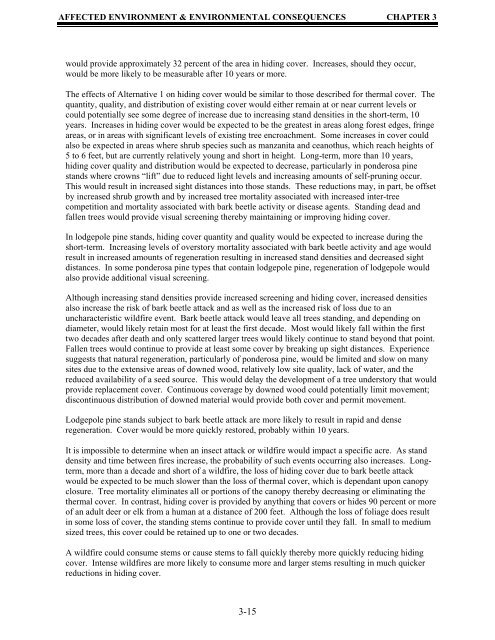Environmental Assessment
Environmental Assessment
Environmental Assessment
You also want an ePaper? Increase the reach of your titles
YUMPU automatically turns print PDFs into web optimized ePapers that Google loves.
AFFECTED ENVIRONMENT & ENVIRONMENTAL CONSEQUENCES CHAPTER 3<br />
would provide approximately 32 percent of the area in hiding cover. Increases, should they occur,<br />
would be more likely to be measurable after 10 years or more.<br />
The effects of Alternative 1 on hiding cover would be similar to those described for thermal cover. The<br />
quantity, quality, and distribution of existing cover would either remain at or near current levels or<br />
could potentially see some degree of increase due to increasing stand densities in the short-term, 10<br />
years. Increases in hiding cover would be expected to be the greatest in areas along forest edges, fringe<br />
areas, or in areas with significant levels of existing tree encroachment. Some increases in cover could<br />
also be expected in areas where shrub species such as manzanita and ceanothus, which reach heights of<br />
5 to 6 feet, but are currently relatively young and short in height. Long-term, more than 10 years,<br />
hiding cover quality and distribution would be expected to decrease, particularly in ponderosa pine<br />
stands where crowns “lift” due to reduced light levels and increasing amounts of self-pruning occur.<br />
This would result in increased sight distances into those stands. These reductions may, in part, be offset<br />
by increased shrub growth and by increased tree mortality associated with increased inter-tree<br />
competition and mortality associated with bark beetle activity or disease agents. Standing dead and<br />
fallen trees would provide visual screening thereby maintaining or improving hiding cover.<br />
In lodgepole pine stands, hiding cover quantity and quality would be expected to increase during the<br />
short-term. Increasing levels of overstory mortality associated with bark beetle activity and age would<br />
result in increased amounts of regeneration resulting in increased stand densities and decreased sight<br />
distances. In some ponderosa pine types that contain lodgepole pine, regeneration of lodgepole would<br />
also provide additional visual screening.<br />
Although increasing stand densities provide increased screening and hiding cover, increased densities<br />
also increase the risk of bark beetle attack and as well as the increased risk of loss due to an<br />
uncharacteristic wildfire event. Bark beetle attack would leave all trees standing, and depending on<br />
diameter, would likely retain most for at least the first decade. Most would likely fall within the first<br />
two decades after death and only scattered larger trees would likely continue to stand beyond that point.<br />
Fallen trees would continue to provide at least some cover by breaking up sight distances. Experience<br />
suggests that natural regeneration, particularly of ponderosa pine, would be limited and slow on many<br />
sites due to the extensive areas of downed wood, relatively low site quality, lack of water, and the<br />
reduced availability of a seed source. This would delay the development of a tree understory that would<br />
provide replacement cover. Continuous coverage by downed wood could potentially limit movement;<br />
discontinuous distribution of downed material would provide both cover and permit movement.<br />
Lodgepole pine stands subject to bark beetle attack are more likely to result in rapid and dense<br />
regeneration. Cover would be more quickly restored, probably within 10 years.<br />
It is impossible to determine when an insect attack or wildfire would impact a specific acre. As stand<br />
density and time between fires increase, the probability of such events occurring also increases. Longterm,<br />
more than a decade and short of a wildfire, the loss of hiding cover due to bark beetle attack<br />
would be expected to be much slower than the loss of thermal cover, which is dependant upon canopy<br />
closure. Tree mortality eliminates all or portions of the canopy thereby decreasing or eliminating the<br />
thermal cover. In contrast, hiding cover is provided by anything that covers or hides 90 percent or more<br />
of an adult deer or elk from a human at a distance of 200 feet. Although the loss of foliage does result<br />
in some loss of cover, the standing stems continue to provide cover until they fall. In small to medium<br />
sized trees, this cover could be retained up to one or two decades.<br />
A wildfire could consume stems or cause stems to fall quickly thereby more quickly reducing hiding<br />
cover. Intense wildfires are more likely to consume more and larger stems resulting in much quicker<br />
reductions in hiding cover.<br />
3-15
















